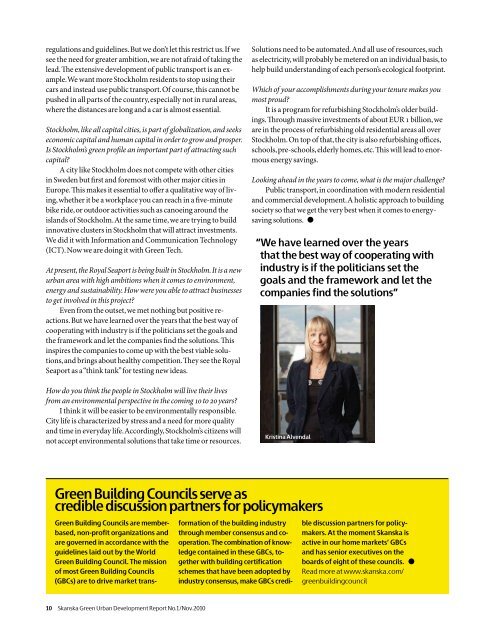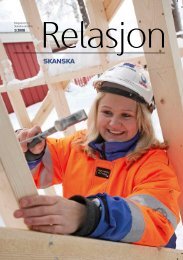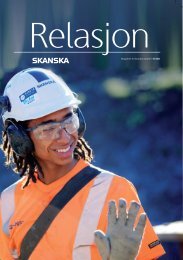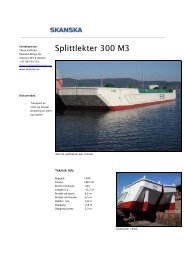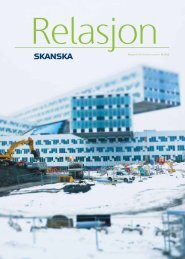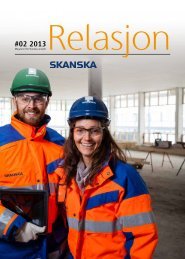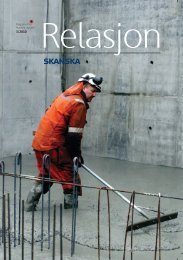Green Urban Development Report No.1 - Skanska
Green Urban Development Report No.1 - Skanska
Green Urban Development Report No.1 - Skanska
You also want an ePaper? Increase the reach of your titles
YUMPU automatically turns print PDFs into web optimized ePapers that Google loves.
egulations and guidelines. But we don’t let this restrict us. If we<br />
see the need for greater ambition, we are not afraid of taking the<br />
lead. The extensive development of public transport is an example.<br />
We want more Stockholm residents to stop using their<br />
cars and instead use public transport. Of course, this cannot be<br />
pushed in all parts of the country, especially not in rural areas,<br />
where the distances are long and a car is almost essential.<br />
Stockholm, like all capital cities, is part of globalization, and seeks<br />
economic capital and human capital in order to grow and prosper.<br />
Is Stock holm’s green profile an important part of attracting such<br />
capital<br />
A city like Stockholm does not compete with other cities<br />
in Sweden but first and foremost with other major cities in<br />
Europe. This makes it essential to offer a qualitative way of living,<br />
whether it be a workplace you can reach in a five-minute<br />
bike ride, or outdoor activities such as canoeing around the<br />
islands of Stockholm. At the same time, we are trying to build<br />
innovative clusters in Stockholm that will attract investments.<br />
We did it with Information and Communication Technology<br />
(ICT). Now we are doing it with <strong>Green</strong> Tech.<br />
At present, the Royal Seaport is being built in Stockholm. It is a new<br />
urban area with high ambitions when it comes to environment,<br />
energy and sustain ability. How were you able to attract businesses<br />
to get involved in this project<br />
Even from the outset, we met nothing but positive reactions.<br />
But we have learned over the years that the best way of<br />
cooperating with industry is if the politicians set the goals and<br />
the framework and let the companies find the solutions. This<br />
inspires the companies to come up with the best viable solutions,<br />
and brings about healthy competition. They see the Royal<br />
Seaport as a “think tank” for testing new ideas.<br />
How do you think the people in Stockholm will live their lives<br />
from an environmental perspective in the coming 10 to 20 years<br />
I think it will be easier to be environ mentally responsible.<br />
City life is characterized by stress and a need for more quality<br />
and time in everyday life. Accordingly, Stockholm’s citizens will<br />
not accept environmental solutions that take time or resources.<br />
Solutions need to be automated. And all use of resources, such<br />
as electricity, will probably be metered on an individual basis, to<br />
help build understanding of each person’s ecological footprint.<br />
Which of your accomplishments during your tenure makes you<br />
most proud<br />
It is a program for refurbishing Stockholm’s older buildings.<br />
Through massive investments of about EUR 1 billion, we<br />
are in the process of refurbishing old residential areas all over<br />
Stockholm. On top of that, the city is also refurbishing offices,<br />
schools, pre-schools, elderly homes, etc. This will lead to enormous<br />
energy savings.<br />
Looking ahead in the years to come, what is the major challenge<br />
Public transport, in coordination with modern residential<br />
and commercial development. A holistic approach to building<br />
society so that we get the very best when it comes to energysaving<br />
solutions. ●<br />
“We have learned over the years<br />
that the best way of cooperating with<br />
industry is if the politicians set the<br />
goals and the framework and let the<br />
companies find the solutions”<br />
Kristina Alvendal<br />
<strong>Green</strong> Building Councils serve as<br />
credible discussion partners for policymakers<br />
<strong>Green</strong> Building Councils are memberbased,<br />
non-profit orga ni za tions and<br />
are governed in accor d ance with the<br />
guidelines laid out by the World<br />
<strong>Green</strong> Building Council. The mission<br />
of most <strong>Green</strong> Building Coun cils<br />
(GBCs) are to drive market trans -<br />
for mation of the building in dustry<br />
through mem ber consensus and cooperation.<br />
The combination of knowledge<br />
contain ed in these GBCs, together<br />
with building certi fi cation<br />
schemes that have been adop ted by<br />
industry con sensus, make GBCs cre di-<br />
ble discus sion part ners for policymakers.<br />
At the mo ment <strong>Skanska</strong> is<br />
active in our home markets’ GBCs<br />
and has senior executives on the<br />
boards of eight of these councils. ●<br />
Read more at www.skanska.com/<br />
greenbuildingcouncil<br />
10 <strong>Skanska</strong> <strong>Green</strong> <strong>Urban</strong> <strong>Development</strong> <strong>Report</strong> <strong>No.1</strong>/Nov. 2010


